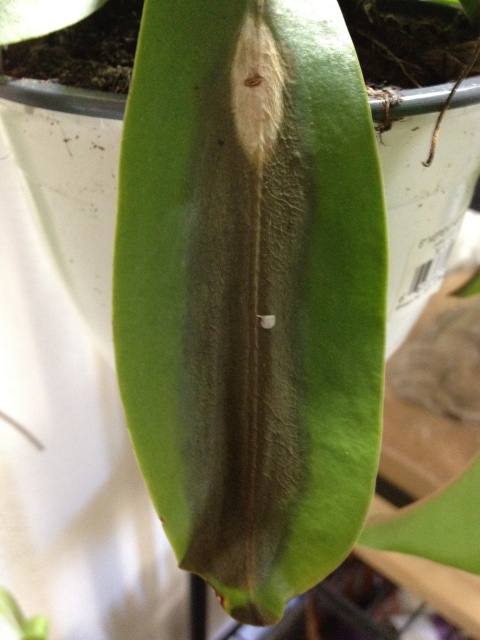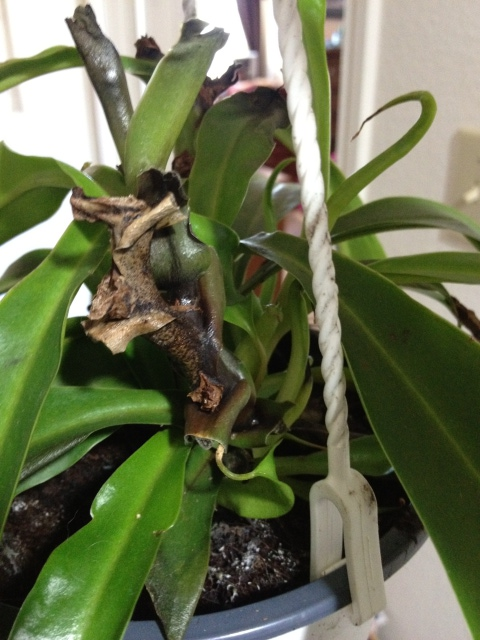Question
 Black spots
Black spots  Growth shoot turning b
Growth shoot turning b
1) The species of carnivorous plant you're growing.
nepenthes miranda
2) A concise description of a single issue. (One issue per submission. No multiple questions, please.)
My plant is developing black spots on the leaves and some of the growth shoots. The black spots are growing from the middle of the leaf outward.
3) The type of lighting, water and soil you're using, as well as how long you've grown the plant.
We use artificial lighting- 26 watt CFL which is equivalent to 100 watt incandescent. We use tap water (read conflicting data, some say its ok to use tap water some say distilled). I have never re-planted this plant so the soil that it came in looks like a sphagnum moss mixture. I bought this plant from a grocery store about 1-2 months ago. It was in perfect condition when I bought it.
4) Your region to assess seasonal issues (e.g. Florida Panhandle, Northern Illinois).
Region is the midwest. we keep it inside because of the swift weather changes. we dont have a west window because we live in an apartment, we have a east, south window but the south window is very shady. Right now we are just using the artificial lighting we keep it on for 14 hours during the day.
I am attaching pictures, I have more images if needed.
AnswerYour plant is showing signs of insufficient lighting. Nepenthes Miranda needs strong lighting to thrive. The plant should get several hours of direct sunlight with bright filtered sun for the rest of the day. You will know the plant is getting sufficient sun when the leaves turn red. Right now, your leaves are bright green, which is one of the signs of poor lighting for this particular plant. The leaves and shoots are also turning black because the plant doesn't have enough light to produce energy via photosynthesis. Without energy, the plant will begin to shut down parts of itself to conserve energy and make do with what little light there is. (Keep in mind that what you think is bright enough is often irrelevant. The plant is always the final judge of what is bright enough.)
There's nothing you can do to reverse the damage. It's best to cut off the dead leaves and shoots to prevent opportunistic infections. You can also prevent further damage by increasing your light source.
Use T5 fluorescent tubes. You can find T5 tubes (24 inches) and fixtures at your local hardware store or garden center. Try Lowe's or Home Depot. Use double tubes, 58 watts (actual output) per tube. This wattage is necessary to provide the proper light intensity. The light source should be no more than 12 inches above the plant.
This may or may not be sufficient. It's difficult to say because I generally don't grow large Nepenthes under artificial lights. I find that most artificial lights lack the intensity to reach the lower sections of the plant. A second light fixture may be necessary if the black spots continue.
You might also need to accept the fact that the plant won't be producing pitchers during the winter months. One of the signs of low lighting is lack of new pitchers. Pitcher production will resume when light levels increase.
From your second photo, I also see white patches on the soil. This could be mold, another classic symptom of low lighting. Use a sulfur fungicide on the soil surface to treat it. You may need to spray periodically to prevent future mold growth. It's also hard to say if the mold is affecting your plant, but you should treat it regardless.
You can also prevent future mold growth by watering your plant only when the top soil begins to lose dampness. Avoid keeping the soil too wet, particularly if lighting is not sufficient.
If you want to grow Nepenthes, I recommend start with smaller plants that will grow better under artificial lights. Large plants are very difficult to keep healthy under artificial lights unless you are willing to invest in expensive set ups. (We use 400-watt metal halide lights in our Nepenthes greenhouse. Each fixture is $250. This is what's necessary to keep our plants healthy during cloudy winters in Oregon.)
For more information about growing Nepenthes, consider the following resources:
http://www.growcarnivorousplants.com/careguides
http://www.growcarnivorousplants.com/dvd
Good growing!
Jacob Farin







